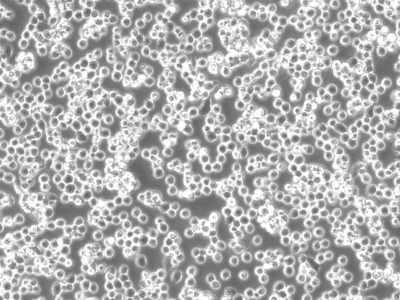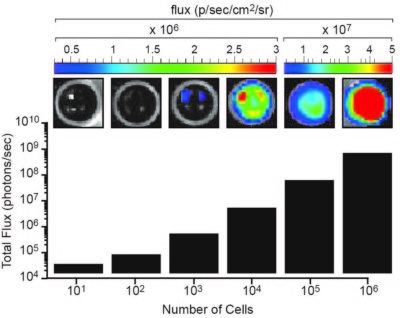A20-Fluc-Puro
| Species | Mouse |
| Cell Type | Lymphoma |
| Transgene | Firefly luciferase (Fluc) |
| Selection Gene | Puromycin resistance (puro) |
-
Description
This is a cell line derived from the murine lymphoma A20 cell line (ATCC® TIB-208TM). Parental A20 cells were transduced with LV-Fluc-P2A-Puro (LV012) encoding the firefly luciferase (Fluc) cDNA under the spleen focus-forming virus (SFFV) promoter and linked to the puromycin resistance gene (Puro) via a P2A cleavage peptide. A high Fluc expressing population was generated by selection using puromycin followed by selection using a methylcellulose based semi-solid medium.
*The ATCC trademark and trade name and any and all ATCC catalog numbers are trademarks of the American Type Culture Collection.
Due to the immunogenicity of the reporter genes in this cell line, we recommend using immunocompromised mice for in vivo studies.
Replication Competent Lentivirus (RCL) Test (including a test report) is available for this cell line at an added cost. Contact us to learn more.
-
Characterization
Morphology

Cell photo taken at 200x magnification.
Luciferase Expression
 The indicated number of cells were placed in wells of a 96-well plate. After the addition of 3 mg/mL d-luciferin, the plate was immediately imaged using an IVIS Spectrum. The total flux (photons/sec) was plotted as a function of cell number.
The indicated number of cells were placed in wells of a 96-well plate. After the addition of 3 mg/mL d-luciferin, the plate was immediately imaged using an IVIS Spectrum. The total flux (photons/sec) was plotted as a function of cell number. -
Growth Conditions
Complete Growth Medium: RPMI supplemented with 10% FBS, 1x penicillin/streptomycin, 50uM ß-mercaptoethanol, and 1 µg/mL puromycin.
The addition of puromycin to the complete growth medium maintains high reporter expression over continued passage of the cells. It is recommended, especially if the cells undergo multiple passages prior to being used for studies.
These cells should be grown in the indicated medium and subcultured as needed to maintain a density between 5 x 105 and 2 x 106 cells/mL. The cells have a tendency to clump. For optimal growth, frequent passaging at lower subcultivation ratios is recommended. The cells can be passaged by dilution in fresh medium. Regular passaging using centrifugation is recommended to limit the amount of debris in cultures.
-
Usage Information
These cells are suitable for in vitro and in vivo experimentation. A20 cells form tumors and metastases at multiple sites, including the liver, lymph nodes, spleen, bone marrow, ovaries, and peritoneal cavity, upon implantation into syngeneic Balb/c mice1.
The Fluc transgene facilitates in vivo noninvasive bioluminescent imaging of implanted cells. The cells can be amplified in vitro and used to generate additional frozen stocks. Cryopreservation of low passage stocks is recommended. Frozen stocks should be preserved in a designated cryopreservation medium.
These cells were generated via lentiviral vector transduction. The lentiviral vector used for transduction was a self-inactivating (SIN) vector in which the viral enhancer and promoter have been deleted. Transcription inactivation of the LTR in the SIN provirus increases biosafety by preventing mobilization by replication competent viruses and enables regulated expression of the genes from the internal promoters without cis-acting effects of the LTR2. Nevertheless, all work with these cells should be performed under biosafety-level 2 (BSL2) conditions by trained personnel. Institutional requirements may permit handling of these cells under BSL1 conditions if certain criteria are met.
References:
-
Datasheet/COA
Lot Number CL-IM221